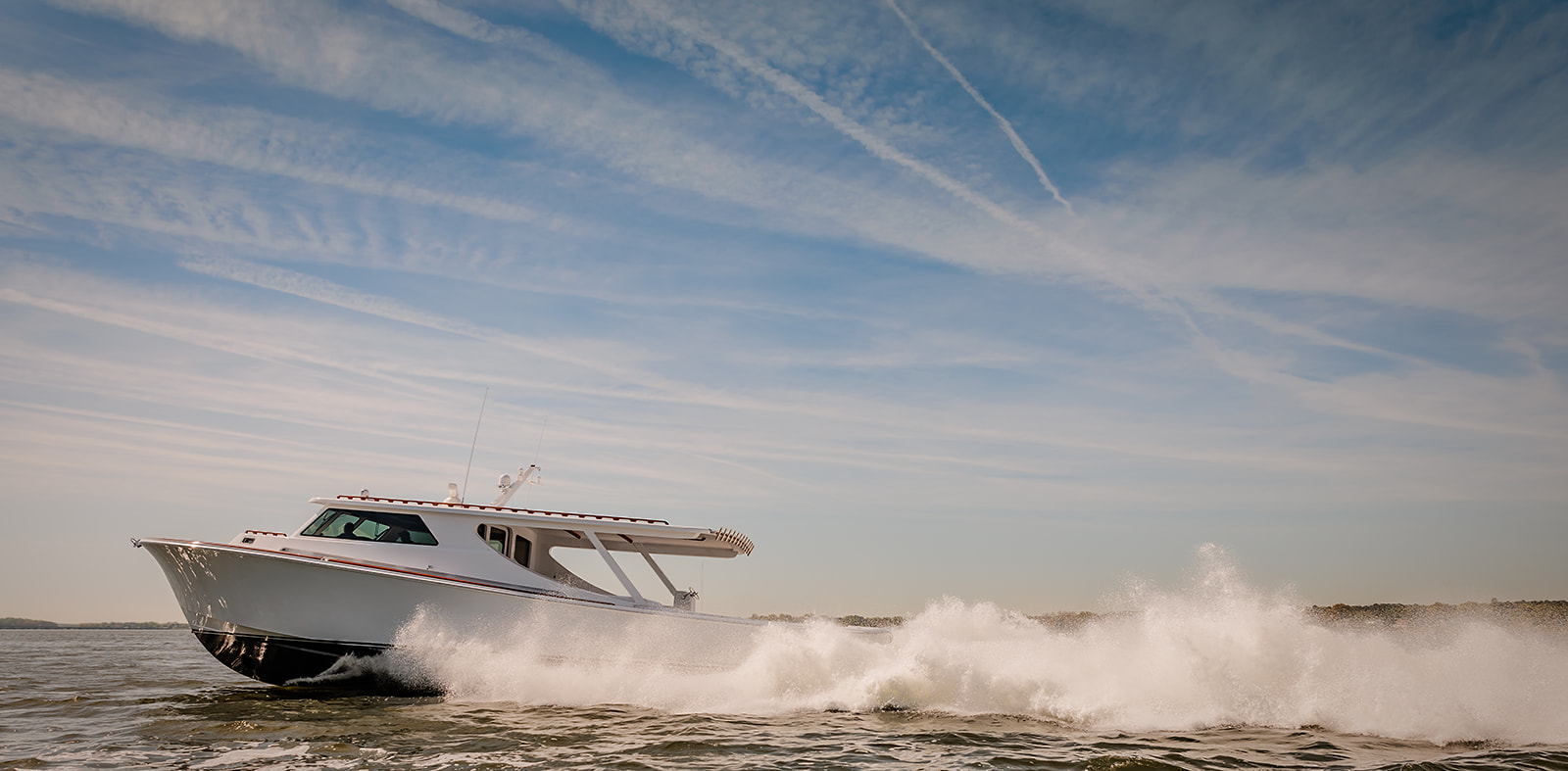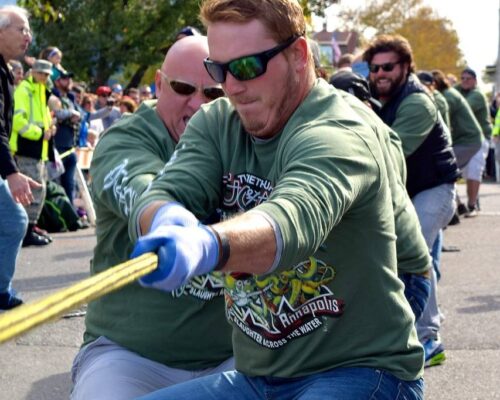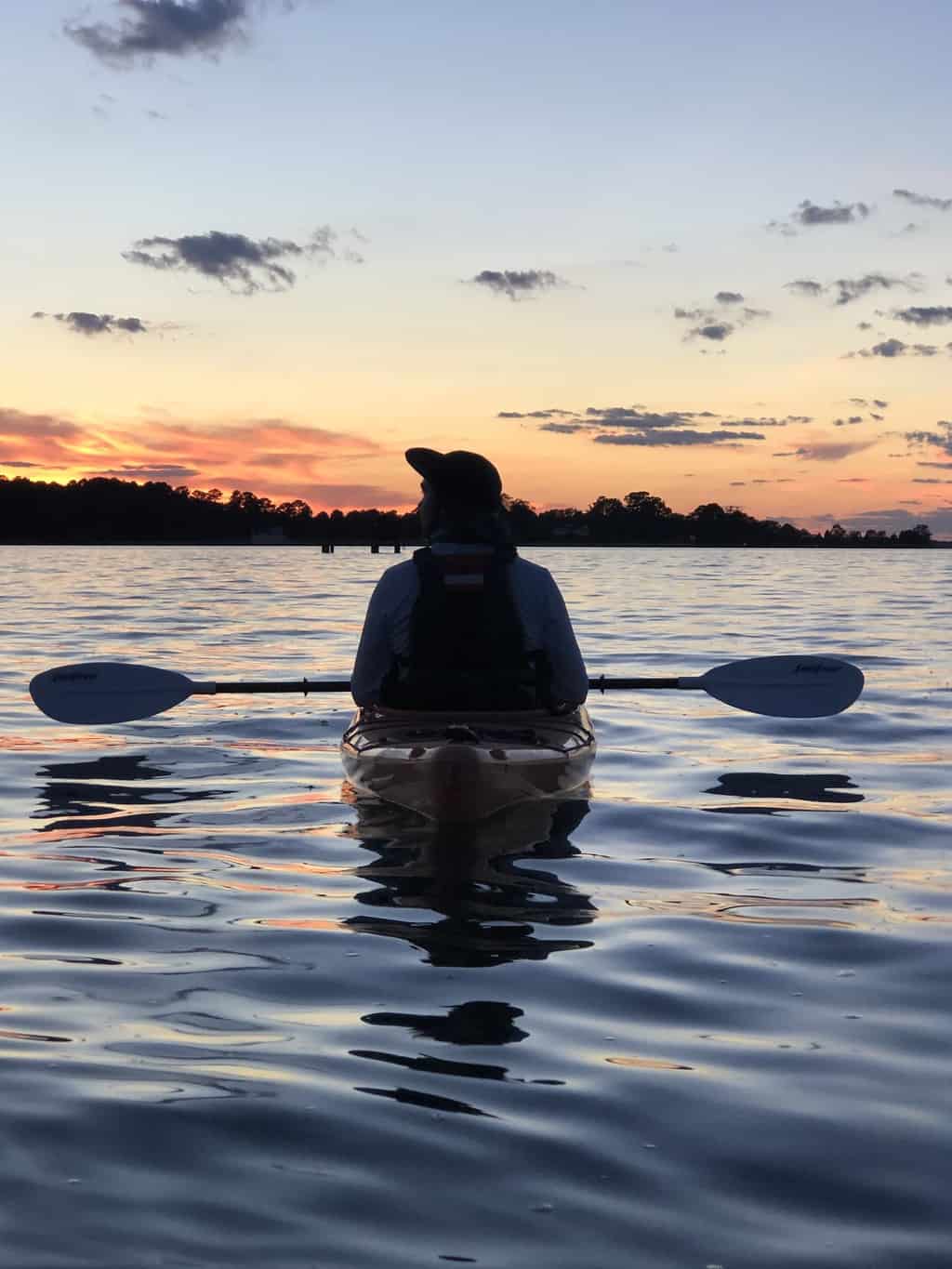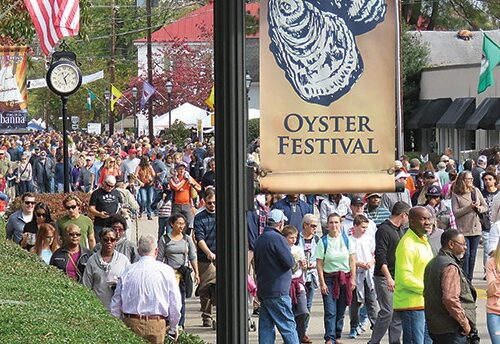Composite Yachts 55
- LOA: 55′
- Beam: 16’5″
- Draft: 2’8″
- Weight: 55,000 lb (estimated, with gear)
- Transom Deadrise: 17º
- Bow Deadrise: 48º
- Max Power: 3,880
For more information, visit compositeyacht.biz.
At 55′ long, Skinny Witch tops out at 55 knots (63.5 statute miles per hour). Some folks would say she’s the loveliest, too. That’s certainly the opinion of Jerry Murrell, her owner. He loves the graceful, traditional profile of her sheer line, tumble home and deckhouse, to say nothing of the beauty of her teak and mahogany bright work. And he loves her speed, which allows him and his family to fish her all over the Chesapeake from her home in a creek at the mouth of the Potomac River in Southern Maryland.
Commissioned in May, she has already proven that she catches fish. Two specialties to date have been trolling for rockfish, with parachute jigs behind planer boards, and for cobia, with big red surgical hose eels. She has also proven adept, under the direction of skillful skippers, at sight-casting to cobia with large orange bucktails and live eels. Since each of those techniques requires careful speed control and precise handling, their success is testimony that she is much more than just a pretty go-fast. The speed doesn’t hurt, though, since she can and does easily fish anywhere from the Potomac’s Cobb Island down to the American Mariner wreck in the Southwest Middlegrounds, Windmill Point at the mouth of the Rappahannock, and even outside the Virginia Capes off Rudee Inlet(a two-hour run, “loafing” at 48 knots). At summer’s end, she even did some bottom-fishing for spot, croakers and white perch with her three generations of the Murrell Family, and the fall season finds her jigging for rockfish. As the weather turns colder, she’ll be a natural to run-and-gun looking for gannet storms, with those big, spectacular birds diving on baitfish to signal schools of rockfish attacking from beneath.
The Design
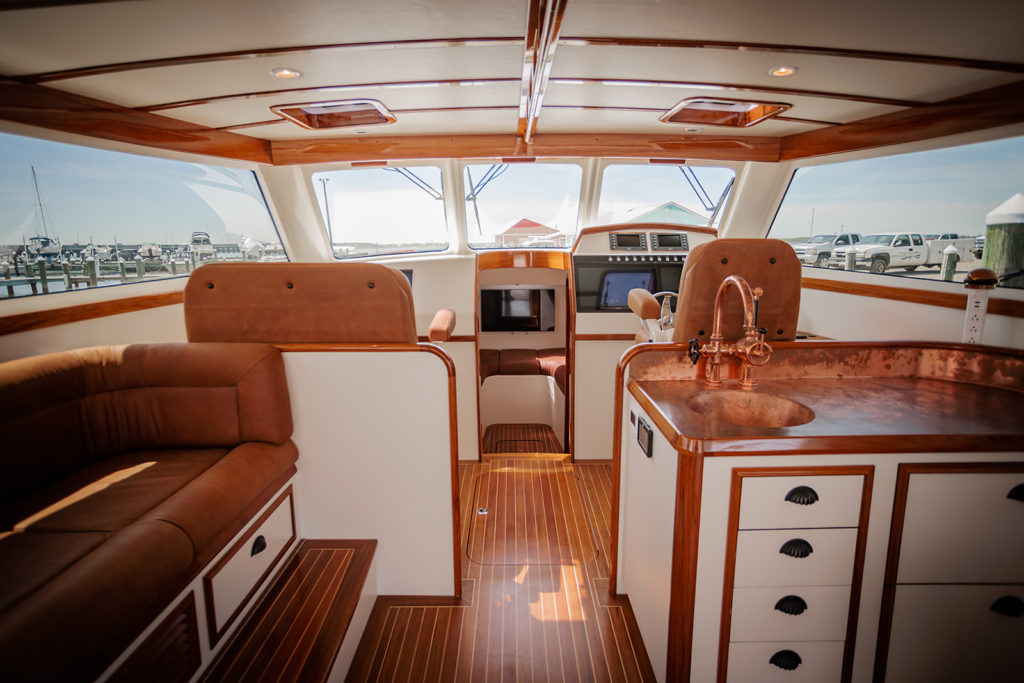
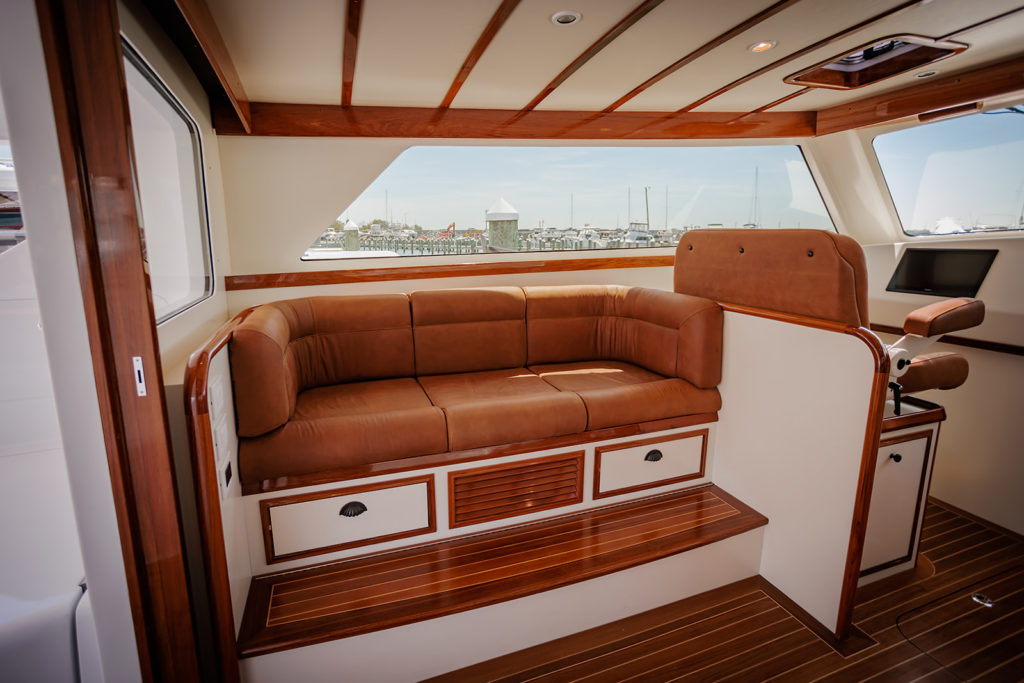
So where did this extraordinary deadrise come from? It turns out that she’s as local as Composite Yachts, on the Choptank River, but with design consultation from as far as Ann Arbor, Mich., and twin MTU diesels from Germany. Murrell’s concept, which he came up with some five years ago, was a 55′ yacht-grade deadrise that could run 55 knots. He asked several builders about such a project, but the honest answer that most impressed him was “I don’t know. Let’s hire an architect, build it on paper, then test it.” That came from Lewis Hardy, who with his father, Martin, and brother, Rob, own and run Composite Yacht, an established firm in Trappe, Md., across the river from Cambridge, that has deep expertise in everything from traditional wooden boat carpentry to 21st-century infused Kevlar and carbon fiber construction. The architect who took on the challenge was Lou Codega—best known as the designer of Regulators, but who also has extensive experience drawing high-speed small craft for the military services.
“Jerry Murrell wanted a deadrise-style boat that’s really fast. The trick in design,” Codega told us, “forces the helm into forward position. To run soft in a Bay chop, I had to make the forefoot as sharp as possible without bow-steer. Being big buys you ride quality, especially in the Chesapeake. She measures 55′ with only 16′-plus of beam. (Thus her appropriate name: Skinny Witch. Murrell always names his boats after his wife Janie, and Skinny Witch is her childhood nickname.)
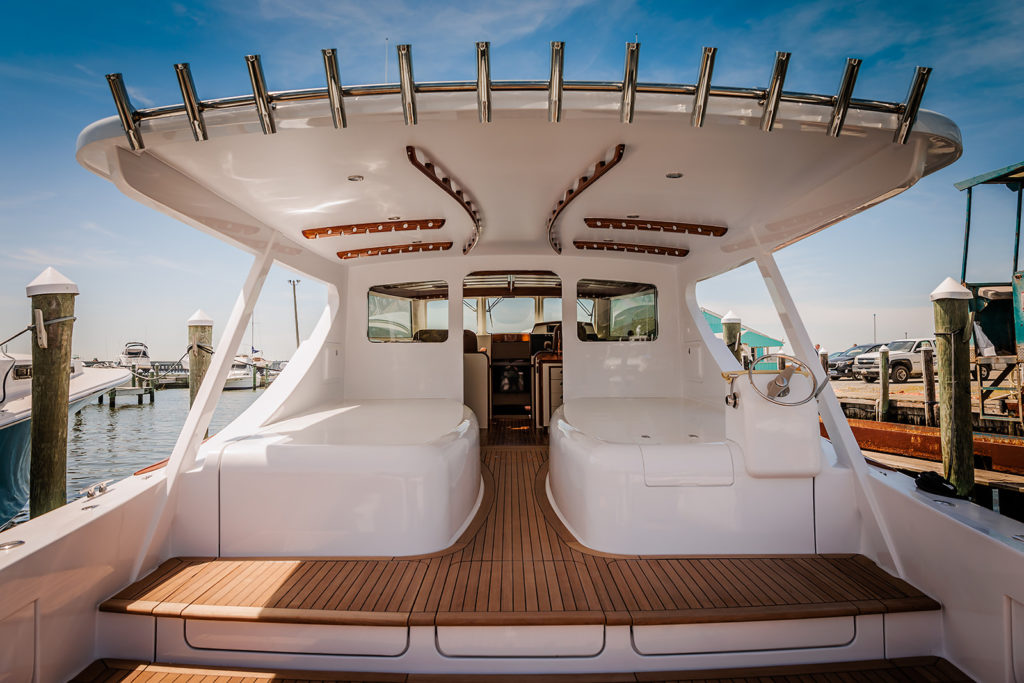
“I based the beam around the engines,” he said. “Styling cues come from traditional deadrises but she’s more streamlined, and nothing below the chines resembles a semi-displacement deadrise. She’s pure go-fast, with a 17-degree deadrise at the transom twisting to a sharp 48 degrees at the bow. The waterline is slender up forward, with high chines. There was a narrow band of design around the twin engines, 1940-hp MTU 12V 2000 M96Xs with 1.75:1 ZF V-drives, turning custom propellers through wake-adapted struts and rudders in shallow pockets, balanced with seven-degree shaft angles and three Humphree interceptors across the transom.” Codega, Murrell and the Hardys took the design to New Jersey’s Stevens Institute of Technology for the tank testing. “The model tests verified the design’s ability to achieve astounding numbers,” Lou told us.
Even so, there was more engineering to do. “The top 5% of our speed took 50% of our budget,” Lewis Hardy added. “Jerry allowed me to hire anybody I needed to make this project a success.” The team called in University of Michigan hydrodynamic specialist Dr. Brant Savander and his firm, Maritime Research, LLC, of Ann Arbor. The powerful Maritime Research computers reviewed the design, the Stevens Institute data and the hydrodynamics of the propeller shaft struts and rudders, running simulations of the bottom’s behavior at speed. “The simulations let us see pressure points,” said Lewis. “They looked like clouds, showing cavitation. Then we had to wait while the computer ran for weeks to simulate modifications that could eliminate those pressures. Al Horsmon, another Michigan naval architect, worked out all of the structural engineering for laminates and hardware in the resulting hull form. That’s how much time and detail went into this one design.”
The Build
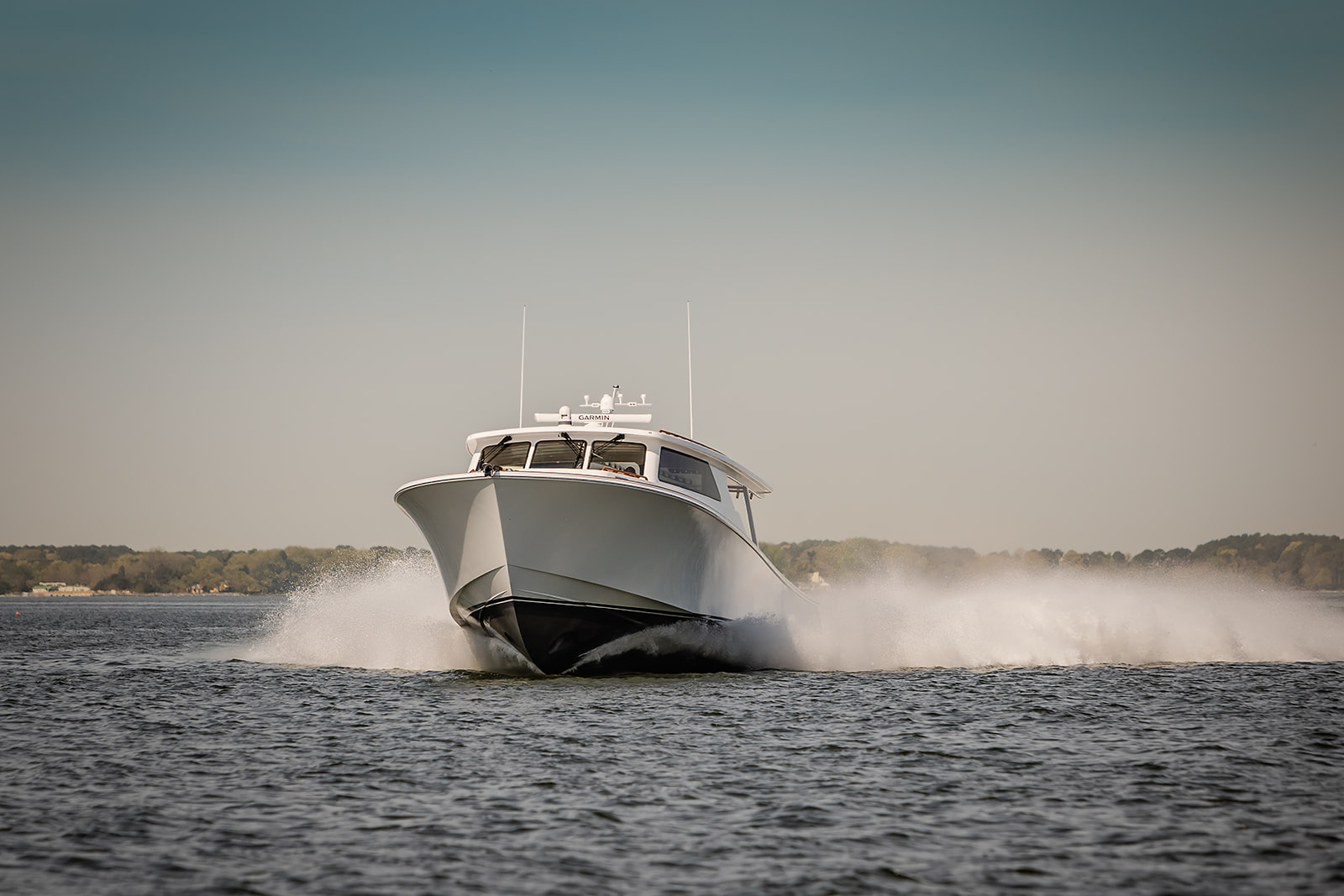
“We built test laminates,” Lewis recalled, “and then a test boat (a CY 26, the yard’s classic design), using a new build process with Scott Bader Company and composites consultant Jef Benkelman, who brought broad knowledge and experience. We had to learn our way through tricky issues like temperature spikes, viscosity changes in vacuum-bagging, adjusting films to get the precise resin mix for fiber consolidation, and then testing hardness. This is aerospace stuff.”
Construction finally began with spraying gelcoat in June 2019. Laying up the hull took a month. The outer layer of the CY 55’s hull is Kevlar, for puncture resistance. The rest is 95% cored carbon fiber with urethane acrylate resin, laminated, vacuum-bagged and cured in an oven with the temperature and resin viscosity carefully controlled during curing. The layup included fiberglass-cored panels strategically placed everywhere equipment had to be mounted. Fully loaded with engines, generator, Seakeeper and 1,900 gallons of fuel, the boat weighs only 55,000 lbs. Composite Yacht is “the best builder I’ve ever worked with,” said Lou Codega. “There’s a chemistry between Jerry Murrell as owner and the Hardys. Also, I have to mention Leon Lahman, the shop foreman, and Paulo San Juan, who are really, really good at high-tech carbon fiber laminates.”
“Everybody knew what was needed,” said Lewis. “The team gelled from the start. Jerry Murrell stuck to his concept; his project manager, Sean Durand, worked closely with us; and our Composite team looked constantly for small weight reductions that added up. On Wednesdays at 10:00 a.m., we held a full team meeting to go over everything, especially problems. The keyword every day was ‘remain disciplined’ in all facets of the build. There was no wish list, no ‘incremental weight gain.’ Lou had built the design around a weight budget. We hit it close. We were weighing the trashcans at the end of every day.
“The owner stayed with the simple accommodations necessary for fishing boat,” he continued. “He’s a genuinely nice guy, thoughtful and bright. He allowed Lou, us Hardys and the rest of the team to do what we do well.” The boat has a small generator (12.5 kW) to run air conditioning, the Seakeeper and other systems on a 220-volt system, which is lighter than 110. All raw water intakes run through a sea chest to save weight. The batteries are NorthStar lead-acid for simplicity. Ken Houle, the MTU specialist at distributor Johnson & Towers checked in to the shop frequently to make sure installation of the powertrain achieved the full power plus the design-spec balance and shaft angle. The high-performance MTUs ask for 550 gallons per minute of cooling water, so the Composite team had to design and fabricate partial bypass lines around the mufflers, all while keeping within the weight limits.”
Controlling all of that power required special MTU BlueVision controls integrated with the ZF V-drives. They’re “almost like rheostats,” Lewis said, “to ease the boat forward in close-quarters maneuvering. Add in her hydraulic bow thruster and she’s easy to handle around a dock.” Those controls also provide the precision speed control that make Skinny Witch successful at trolling lures like red hoses.
The Murrells have found they “can touch 55 knots any time we want. She cruises especially easily with a soft ride at 1,600 rpm, making 42 knots while burning 80 gallons per hour,” Jerry reported. “The wheels are one-off 34.75″ x 53.90″ Michigan Marlin Nibral 4-blades,” Lewis explained. “Brant Savander specified custom rake and cup for the blades. And yes, they’re ‘a tad out of square,’” he added with a chuckle. The boat is also “wicked quick,” accelerating from zero to 40 knots in 13 seconds and to full throttle in 18. “She’s a slippery little boat,” said Lou Codega with a smile. “She feels alive as she accelerates,” said Rob Hardy. “I’ve never felt anything like it—on the water, on land or in the air.”
Even so, “this is a family and fishing day boat, a fun boat. She’s Spartan belowdecks,” Lewis continued. (That conclusion caused Lou to comment, “She’s simple, but I don’t know if Spartan is the right word. Composite Yacht did an absolutely superb job with the joinerwork and finishes. ‘Elegant in its simplicity’ would be better.”)
“We’re really happy with everything about the boat, especially the beauty,” said Jerry Murrell. “She definitely catches fish. Our builder and naval architect have been fantastic. They all get along together. I can’t think of one thing wrong with the boat. My wife can’t believe how beautiful it is. We love looking for cobia as they move around. Everything is working well, as designed. The systems take a little getting used to, but they are performing as promised.”
So when will Composite Yacht build the next CY55? There are no orders yet, but the Hardys are already thinking about the next project. “The limited-production molds we created for this project could build more 55s,” Lewis concluded. “This design would also produce a really nice boat with a bit less power and simpler laminates.” In the end, this Dream Team of owner, designers and builders has created not only an exceptionally fast Chesapeake fishboat but also one of great beauty, strength and efficiency. It will be interesting to see what elements of the CY55 trickle out to other boats from Composite Yacht.
Pricing varies with custom options. For more info, visit compositeyacht.biz.

